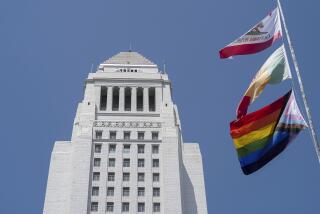The political dynasty that governed Signal Hill...
The political dynasty that governed Signal Hill for many years was even slicker than the underground oil pools that made the city one of the nation’s most affluent municipalities.
The city was created by an oil boom that began June 25, 1921, when a Shell Oil well named Alamitos No. 1 blew a gusher that produced as much as 600 barrels a day. The city was incorporated three years later after oil producers, eager to avoid a tax proposed by neighboring Long Beach, completed the paperwork in secret.
For nearly five decades, oil continued to be what came to mind whenever people heard the name Signal Hill. Beginning in 1967, the city was run by a family whose patriarch, Thomas W. Denham Sr. controlled city government as mayor. His son, Richard, took over as chief of police and another son became a sergeant. The elder Denham died in 1979 while still in office, and his son Richard retired later that year.
The hill had a reputation for being a rough place with rogue cops who needed only a hint of an excuse to use brute force. During the Denham reign, Signal Hill’s police officers were formally accused 42 times of excessive violence or false arrest.
The community’s rough-and-tumble reputation reached a peak in 1981 in a case that garnered national attention. Ron Settles, a black Cal State Long Beach football star, was found hanged in his cell after being arrested for speeding. Police insisted that Settles had hanged himself, but a jury found that Settles had died “at the hands of another.” His family was awarded $760,000 in a wrongful death suit in 1983. No police officers were ever charged.
Around 1980, Signal Hill became known as a gun-toting town after when the police chief handed out 188 permits for concealed weapons--more per capita than any other police chief in Los Angeles County. By last year, that number had declined to three.
These days, with the decline of California’s oil industry, houses have come to outnumber wells on the hill. The city is mining new riches by luring lucrative businesses, including a $200-million auto racing complex.
(BEGIN TEXT OF INFOBOX / INFOGRAPHIC)
By The Numbers
City Business
Date founded: April 26, 1924
Area in square miles: 2.2
Number of parks: 3
Number of city employees: 145
1995-96 budget: $9.2 million
*
People
Population: 8,371
Households: 3,358
Average household size: 2.41
Median age: 31.8
*
Ethnic Breakdown
Asian: 11%
Black: 10%
Latino: 22%
White: 56%
*
Money and Work Median household income: $36,011
Median household income / L.A. County: $34,965
Median home value: $187,000
Employed workers (16 and older): 4,698
Percentage of women employed: 65%
Percentage of men employed: 83%
Self-employed: 309
Car- poolers: 592
*
Number of Cars Per Household
One: 41%
Two: 39%
Three or more: 14%
None: 6%
*
Ages
65 and older: 10%
50- 64: 11%
35- 49: 23%
18- 34: 34%
17 and younger: 22%
Source: Claritas Inc. Household expenses are averages for 1994. All other figures are for 1990. Percentages have been rounded to the nearest whole number.
(BEGIN TEXT OF INFOBOX / INFOGRAPHIC)
Signal Hill Inside Out
Smoke Signals: Signal Hill takes its name from the 365- foot rise that provided a vantage point of Native Americans to signal one another in the coastal basin, on Santa Catalina Island and on the San Pedro Penninsula.
Uplifting History: Signal Hill ad its geologic cousin to the north, Baldwin Hills, were elevated as by activity on the Newport- Inglewood fault. One result of this fault activity was that oil accumulated beneath various anticlines, or domes of rock.
Love’s Lane: To several generations of young Don Juans, Signal Hill’s crest has been theplace to lure dates on the pretense of watching the submarine races. Although submarines are never visible on the distant ocean, lovers and dreamers gather amid television transmitters, a bulky water tower and rusty oil pumps to see the stunning panorama of the city far below.
Oil Marker: Curley’s Cafe, a 63- year- old- landmark from oil boom days and the self- proclaimed home of the best chili for miles around, sits near Willow and Cherry streets with a dark green oil pump bobbing in its parking lot. Its walls are filled with oil memorabilia- pictures of drill bits and derricks- paying tribute to the roughnecks and roustabouts it once served.
In Perpetuity: After the Signal Hill oil strike in 1921, the frenzy was so great that oil drilling equipment was erectedat the Sunnyside Cemeteryon Willow Street. For years afterward, relatives of the deceased received royalty checks for oil drawn from beneath family plots.
Shared Quarters: In the wake of Shell Oil Co.’s discovery, the mansion that liquor magnate Andrew Pala built in 1919 as a retirement home on the crest of the hill became bachelor quartersfor the stream of roughnecks that followed the first gusher. A Swiss sculptor designed the majestic lions, perched on pedestals, that guarded the entrance. Like so many Los Angeles landmarks, it crumbled under a bulldozer’s blade a few decades ago.
Zipless: Tired of sharing three of Long Beach’s ZIP codes, Signal Hill applied to postal officials last year for a zone of their own. But it looks like it might be a long wait.
More to Read
Start your day right
Sign up for Essential California for news, features and recommendations from the L.A. Times and beyond in your inbox six days a week.
You may occasionally receive promotional content from the Los Angeles Times.






